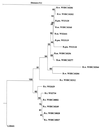The hemolytic enterotoxin HBL is broadly distributed among species of the Bacillus cereus group
- PMID: 10584001
- PMCID: PMC91741
- DOI: 10.1128/AEM.65.12.5436-5442.1999
The hemolytic enterotoxin HBL is broadly distributed among species of the Bacillus cereus group
Abstract
The prevalence of the hemolytic enterotoxin complex HBL was determined in all species of the Bacillus cereus group with the exception of Bacillus anthracis. hblA, encoding the binding subunit B, was detected by PCR and Southern analysis and was confirmed by partial sequencing of 18 strains. The sequences formed two clusters, one including B. cereus and Bacillus thuringiensis strains and the other one consisting of Bacillus mycoides, Bacillus pseudomycoides, and Bacillus weihenstephanensis strains. From eight B. thuringiensis strains, the enterotoxin gene hblA could be amplified. Seven of them also expressed the complete HBL complex as determined with specific antibodies against the L(1), L(2), and B components. Eleven of 16 B. mycoides strains, all 3 B. pseudomyoides strains, 9 of 15 B. weihenstephanensis strains, and 10 of 23 B. cereus strains carried hblA. While HBL was not expressed in the B. pseudomycoides strains, the molecular assays were in accordance with the immunological assays for the majority of the remaining strains. In summary, the hemolytic enterotoxin HBL seems to be broadly distributed among strains of the B. cereus group and relates neither to a certain species nor to a specific environment. The consequences of this finding for food safety considerations need to be evaluated.
Figures


Similar articles
-
Detection of enterotoxic Bacillus cereus and Bacillus thuringiensis strains by PCR analysis.Appl Environ Microbiol. 2001 Jan;67(1):185-9. doi: 10.1128/AEM.67.1.185-189.2001. Appl Environ Microbiol. 2001. PMID: 11133444 Free PMC article.
-
Bacillus weihenstephanensis characteristics are present in Bacillus cereus and Bacillus mycoides strains.FEMS Microbiol Lett. 2013 Apr;341(2):127-37. doi: 10.1111/1574-6968.12106. Epub 2013 Mar 12. FEMS Microbiol Lett. 2013. PMID: 23413955
-
Detection of enterotoxin genes in mosquito-larvicidal Bacillus species.Curr Microbiol. 2002 Sep;45(3):221-5. doi: 10.1007/s00284-001-0105-6. Curr Microbiol. 2002. PMID: 12177746
-
The Bacillus cereus Group: Bacillus Species with Pathogenic Potential.Microbiol Spectr. 2019 May;7(3):10.1128/microbiolspec.gpp3-0032-2018. doi: 10.1128/microbiolspec.GPP3-0032-2018. Microbiol Spectr. 2019. PMID: 31111815 Free PMC article. Review.
-
Production, secretion and biological activity of Bacillus cereus enterotoxins.Toxins (Basel). 2010 Jul;2(7):1690-703. doi: 10.3390/toxins2071690. Epub 2010 Jun 29. Toxins (Basel). 2010. PMID: 22069656 Free PMC article. Review.
Cited by
-
Production and characterization of antibodies against each of the three subunits of the Bacillus cereus nonhemolytic enterotoxin complex.Appl Environ Microbiol. 2005 Dec;71(12):8214-20. doi: 10.1128/AEM.71.12.8214-8220.2005. Appl Environ Microbiol. 2005. PMID: 16332805 Free PMC article.
-
Probiotic Activity of a Bacterial Strain Isolated from Ancient Permafrost Against Salmonella Infection in Mice.Probiotics Antimicrob Proteins. 2012 Sep;4(3):145-53. doi: 10.1007/s12602-012-9105-z. Probiotics Antimicrob Proteins. 2012. PMID: 26782040
-
Discrimination of Bacillus anthracis and closely related microorganisms by analysis of 16S and 23S rRNA with oligonucleotide microarray.Chem Biol Interact. 2008 Jan 30;171(2):212-35. doi: 10.1016/j.cbi.2007.09.002. Epub 2007 Sep 12. Chem Biol Interact. 2008. PMID: 17950718 Free PMC article.
-
Monoclonal antibodies neutralize Bacillus cereus Nhe enterotoxin by inhibiting ordered binding of its three exoprotein components.Infect Immun. 2012 Feb;80(2):832-8. doi: 10.1128/IAI.05681-11. Epub 2011 Nov 21. Infect Immun. 2012. PMID: 22104106 Free PMC article.
-
Enterotoxin production in natural isolates of Bacillaceae outside the Bacillus cereus group.Appl Environ Microbiol. 2002 Jun;68(6):3147-51. doi: 10.1128/AEM.68.6.3147-3151.2002. Appl Environ Microbiol. 2002. PMID: 12039781 Free PMC article.
References
-
- Agata N, Mori M, Ohta M, Suwan S, Ohtani I, Isobe M. A novel dodecadepsipeptide, cereulide, isolated from Bacillus cereus causes vacuole formation in HEp-2 cells. FEMS Microbiol Lett. 1994;121:31–34. - PubMed
-
- Agata N, Ohta M, Arakawa Y, Mori M. The bceT gene of Bacillus cereus encodes an enterotoxic protein. Microbiology. 1995;141:983–988. - PubMed
-
- Ash C, Collins M D. Comparative analysis of 23S ribosomal RNA gene sequences of Bacillus anthracis and emetic Bacillus cereus determined by PCR-direct sequencing. FEMS Microbiol Lett. 1992;94:75–80. - PubMed
-
- Ash C A, Farrow J A E, Dorsch M, Stackebrandt E, Collins M D. Comparative analysis of Bacillus anthracis, Bacillus cereus, and related species on the basis of reverse transcriptase sequencing of 16S rDNA. Int J Syst Bacteriol. 1991;41:343–346. - PubMed
Publication types
MeSH terms
Substances
Associated data
- Actions
- Actions
- Actions
- Actions
- Actions
- Actions
- Actions
- Actions
- Actions
- Actions
- Actions
- Actions
- Actions
- Actions
- Actions
- Actions
- Actions
- Actions
LinkOut - more resources
Full Text Sources
Research Materials

